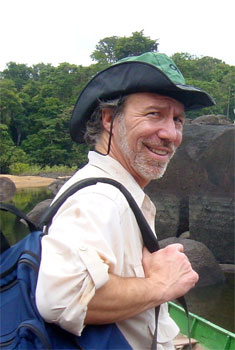Indigenous people are key to rainforest conservation efforts says renowned ethnobotanist
An interview with ethnobotanist Dr. Mark Plotkin:
Indigenous people are key to rainforest conservation efforts
says renowned ethnobotanist
Rhett A. Butler, mongabay.com
October 31, 2006
Integrated biodiversity and cultural conservation can be more effective than traditional protected areas while delivering health benefits to local populations
|
|
Tropical rainforests house hundreds of thousands of species of plants, many of which hold promise for their compounds which can be used to ward off pests and fight human disease. No one understands the secrets of these plants better than indigenous shamans -medicine men and women – who have developed boundless knowledge of this library of flora for curing everything from foot rot to diabetes. But like the forests themselves, the knowledge of these botanical wizards is fast-disappearing due to deforestation and profound cultural transformation among younger generations. The combined loss of this knowledge and these forests irreplaceably impoverishes the world of cultural and biological diversity.
Dr. Mark Plotkin, President of the non-profit Amazon Conservation Team (www.amazonteam.org), is working to stop this fate by partnering with indigenous people to conserve biodiversity, health, and culture in South American rainforests. Plotkin, a renowned ethnobotanist and accomplished author (Tales of a Shaman’s Apprentice, Medicine Quest) who was named one of Time Magazine‘s environmental “Heroes for the Planet,” has spent parts of the past 25 years living and working with shamans in Latin America. Through his experiences, Plotkin has concluded that conservation and the well-being of indigenous people are intrinsically linked — in forests inhabited by indigenous populations, you can’t have one without the other. Plotkin believes that existing conservation initiatives would be better-served by having more integration between indigenous populations and other forest preservation efforts.
Plotkin says the Amazon Conservation Team, working in true partnership with indigenous populations and leading western conservationists, has helped pioneer what it calls “biocultural conservation,” a successful and cost-effective approach to protecting biodiversity, strengthening traditional health systems, and helping preserving culture in a holistic and synergistic way.
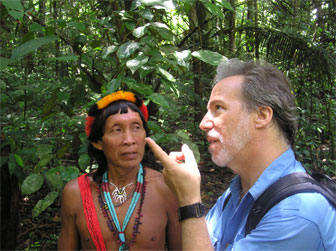 Plotkin with Amasina, a shaman of the Trio tribe in Suriname. Photo courtesy of the Amazon Conservation Team. |
“It’s our strong belief that the people who best know, use, and protect biodiversity are the indigenous people who live in these forests,” said Plotkin. “Our projects are designed to address some of the major threats faced by indigenous groups: loss of indigenous biological wisdom, lack of healthcare, lack of economic opportunity, lack of territorial rights that would protect the rainforest from exploitation, and lack of legal representation. As our executive statement says, the Amazon Conservation Team, ‘ACT helps the keepers of the forest keep the forest!'”
In an October 2006 interview with mongabay.com, Plotkin expanded on these points, offering insight on the difficulties facing indigenous groups in parts of the Amazon and his thoughts on conservation efforts in the region.
Follow up article: Amazon natives use Google Earth, GPS to protect forest home
Rhett A. Butler (Mongabay):
In your view, what are the biggest threats to indigenous people?
Dr. Mark Plotkin (Plotkin): There are two major threats to indigenous people of the rainforest. The first is acculturation — the draw to western culture, the city, and things of that nature. For example, someone may be Mundurucu Indian in genetic terms, but they don’t speak the language, know the legends, or know the plants. In short they are not likely to perpetuate the culture.
Secondly, it’s the destruction of the environment. How can you have a rainforest Indian if there’s no rainforest for them to live in? So this idea of “we’ve got to preserve the culture” OR “we have to preserve the rainforest” is missing the boat. In the interest of preserving the rainforest, we need to preserve cultural diversity. The best way to protect ancestral rainforests is to help the Indians hold on to their culture, and the best way to help them hold onto their culture is to help them protect the rainforest.
Mongabay:
What are their options to fight deforestation? Are legal means the best strategy?
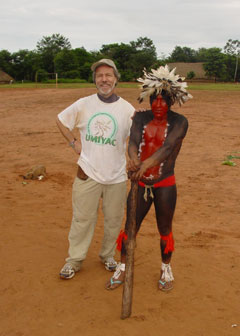 Photo courtesy of the Amazon Conservation Team. |
Plotkin: It depends where you are and with whom you are working. If you’re in southern Suriname where I’ve done a lot of my research, the Indians have no legal title to their lands. With no rights to their lands, as far as the government is concerned from a legal standpoint, they are squatters. So a lot what’s involved is working out land claims in what is hopefully a mutually beneficial way.
The basic strategy is map, manage, protect. In Suriname, we had to begin by mapping in order for the Indians to be able to “stake their claim.”
In Brazil, where indigenous populations have title to land in the sense that a reserve existed on paper, so mapping was focused on establishing the boundaries as much as anything else. We then moved to developing management plans in both countries -in partnership with both the Indians and the government- based on the information gathered as part of the mapping process.
Mongabay:
From the Dorothy Stang murder to violence between miners and the Yanomami, relations between indigenous groups and developers are often portrayed as tense. Have you found this to be the case? How serious is the conflict between these groups?
Plotkin: As the world becomes a smaller place and as there is an increasing demand for raw materials (particularly with the rapid growth of the economies of both China and India, among others) increasing pressure will be put on all resources everywhere. The time for the Indians and their colleagues to prepare for these demands is now (if not yesterday!) if they are to deal with the outside world on their own terms. The point is not to have the Indians keep out the outside world – the point ought to be to better prepare them to deal with these forces on their own terms and to make informed choices.
I believe it’s important to address issues before they arise — once a problem presents itself its often more difficult to solve. For example, it’s better to mark the border before and set up guard posts before you have timber thieves and mines in an Indian area.
Mongabay:
How can we prevent the loss of cultural knowledge between generations as youths leave the forest or adopt western practices? Is it fair to try to preserve culture if the next generation of indigenous kids want to move to cities, work on an oil rig, or become loggers? Are youths sometimes mislead to believe these lifestyles are more glamorous than they actually are?
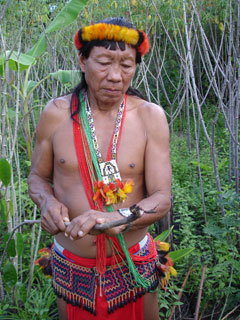 Yaloeefuh, a shaman in Suriname. Mark has been working with Yaloeefuh since 1982. Photo courtesy of the Amazon Conservation Team. 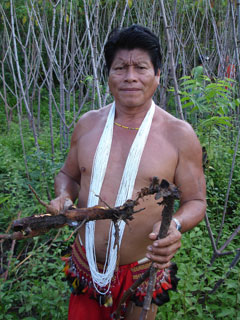 Wuta of the Trio tribe. Photo courtesy of the Amazon Conservation Team. |
Plotkin: One of my great heroes – Wuta of the Trio tribe in the northeast Amazon – packed up and left the forest to go to the city about a decade ago. He ended up finding employment as a night watchman at a milk factory. You can imagine how much a night watchman makes in a third world country! He started losing weight because he couldn’t pick up his bow and arrow to hunt. His kids got malaria because they were living in a slum. He ended up going back to the forest with his family and is now our lead cartographer in the northeast Amazon. He has personally been in charge of mapping 20 million acres of rainforest and training members of four other tribes to do so. I believe he’s the kind of guy who all these tropical conservation outfits should be giving awards to instead of the same old white guys!
But the point to all this is he made his own choice, he moved to the city, and once he was there, he said “this is not an attractive proposition here.” I believe our job as conservationists in a lot of these cases is to help people make informed choices. I’ve taken Indian chiefs up in planes, flown them over deforested areas, and said “yes, you guys get jobs if the loggers come in, but what are you going to eat when there’s no rainforest?” We’ve paddled through rivers where gold had been mined and said, “Yeah OK, these guys made some money but now they can’t drink the water or the money either – so what are they going to do? But it’s your choice.”
People like to talk about how different indigenous peoples are than us as westerners but people are often really much the same at the end of the day. What do they want? They want a good life. They want a decent life for their kids. They want clean air and water. And if you tell them OK you can have more money in your pocket but all this other stuff is going to disappear — potable water, your medicine, your food, your sacred sites – it becomes a pretty obvious choice.
Sure, as long as they think they white man has it all and it’s a simple as moving to the city where they get iPods, two cars, and air conditioning, western life can seem so seductive that they think “oh, let me become a white man or woman because that’s where the action is.” But we’re helping them understand the realities, while at the same time embracing some of the positive aspects of western culture. For example, we’ve got the son of the chief looking at Google Earth to determine where the gold mines are near their borders. That’s the perfect combo of western technology and indigenous custom and know-how. We’ve got guys painted red and nothing else, walking through the jungle with GPS units and that’s the ideal marriage of shamanic wisdom with 21st century western know-how. That’s the sweet spot, the best of both worlds. It’s not whether western civilization is superior or indigenous culture is superior. Any culture in the modern world has something to offer that they do very well.
Mongabay:
What is the Amazon Conservation Team doing to help preserve traditional knowledge?
Plotkin: The loss of indigenous knowledge and culture is of a form of impoverishment. We’re working in partnership with the Indians and the local governments to prevent this type of cultural degradation through the Shamans and Apprentices Program where we get young people together with elders so traditional knowledge is passed on to the next generation. Not only do we have fathers and mothers working with sons and daughters, but grandparents working with grandchildren.
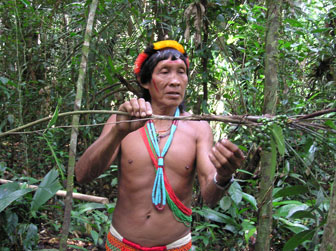 Yaloeefuh, a Trio shaman in Suriname. Photo courtesy of the Amazon Conservation Team. |
Traditional medicine clinics, fully operated and directed by elder tribal shamans, are established near western health care centers in villages. The clinics serve as a place where apprentices can directly observe the shamans actively practicing their medicine. Apprentices also accompany shamans on their plant collection trips. The system has proven very effective at improving health care while keeping medicinal plant knowledge within the tribe.
Mongabay:
What can we learn from indigenous people?
Plotkin: It seems to be that people get quite hung up on the medicine because it’s so sexy and interesting — I was seduced by it a long time ago! — but there’s a lot more than that. There is indigenous agriculture. They use all sorts of varieties of plants that are drought and pest-resistant. There is certainly indigenous knowledge of how to manage the forest and the animals that live therein. There are certain philosophies, music, and cultures, not just a list of medicinal plants. I don’t want to live in a world that is dominated solely by Madonna and the NBA. I like my culture, but I think there are things in other cultures that I find equally interesting. This explains why, for example, there are Thai restaurants above the Arctic circle and avid interest in indigenous art from far-off places.
Mongabay:
Conservation generally comes down to money. Is there a way to make conservation and sustainable development viable concerns on their own or will they always require outside subsidies? Are things like eco tourism and the collection of forest products solutions?
Plotkin: Once again, you have to consider local conditions. I’m a great believer that eco tourism is incredibly important and incredible difficult with indigenous peoples. So I certainly wouldn’t put that at the top of the list.
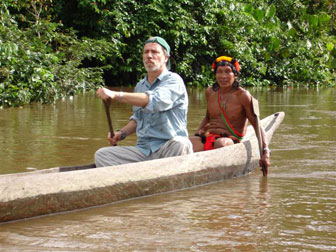 Plotkin with Amasina, a shaman of the Trio tribe in Suriname. Photo courtesy of the Amazon Conservation Team. |
Why not have these guys work as border guards for the government? The government often don’t have much of a presence in forested border areas — who better to serve as the eyes and ears to watch for Colombian drug smugglers, al Qaeda gunrunners, and Brazilian gold miners.
While there’s a lot of focus on medicinal plants, there are other forest products that are valuable and can be sold to the outside world. For example, recently I recently came across dried chile pepper powder that was being sold in Colombian markets that came from Amazon Indians. Turns out that its easier to chop up, dry, and ship the chile powder than bulky Brazil nuts.
While it’s not as exciting as medicinal drugs, traditional handicrafts are popular especially among tourists. These can be crafted in villages and sent to city markets and stores.
There are many options. Start by asking the people themselves what they have, what they want to market, what they don’t want to market, and if they are interested in marketing it. The idea once again is to allow these people to make informed choices. It’s ultimately their choice, not ours, and I believe strongly in teaching entrepreneurial spirit and self-reliance. The idea is to say we could do this and make some money. We’re there as catalysts and advisers, not there to tell them what to do, because that doesn’t work anyhow. Again maybe it sounds kind of Pollyannaish but I think that’s the best way to do it. Prepare them to deal with the outside world on their own terms and then see what happens. In an ideal world they get jobs as park guards so they have a steady source of income and their income is based on protecting the environment rather than destroying it.
Unlike when I first went down there 25 years or so ago, these guys have a real need for income, not income for a mortgage or a car, but income for fish hooks, flashlights, and batteries and stuff like that. So what we can do is find some ways of generating income once again based on protecting the forest, protecting the culture, in a way that doesn’t disrupt the culture or the rainforest. This is not rocket science it is pretty straight forward.
Mongabay:
What is the best way to save rainforests?
Plotkin: I think the single most effective way to protect the type of rainforest that indigenous people inhabit is to involve them in the conservation process. They have a lot vested in the preservation of the rainforest ecosystem. That’s where to get their water, their medicines, make their bows and arrows. Park guards are often not from that area, in fact they are from somewhere far away and sometimes they don’t even live in the park.
 Simon, a Sikiyana apprentice in Suriname. Photo courtesy of the Amazon Conservation Team. |
Here’s a concrete example. The Tumucumaque reserve on the Suriname border is inhabited by 4000 Indians, it has one gold mine. Tumucumaque national park is about the same size, maybe a little smaller, on the border of French Guiana, is officially inhabited by nobody and has between 10 and 25 gold mines, depending on who you believe. The fact is where you have people with poison-tipped arrows it’s a lot less attractive a proposition to destroy that territory and the one next door.
I want to be real clear that I’m not arguing against protected areas – that would be ridiculous. All I’m saying is -number one- we need to pay more attention to, and have more funding for, indigenous areas. And number two, we need to marshal Indians to protect the national parks next door to their territory because it’s in their interest to do so. Look to Brazil where 5 percent of the Amazon forest is protected in national parks, while 25 percent is set aside as indigenous lands. If we can help Indians look after their lands as well as watch over after neighboring nature preserves, we’ll have tremendous conservation leverage.
We must remember that conservation should not be about what’s in it for us. We shouldn’t just save the forest because it might offer the cure to AIDS, hemorrhoids, or pancreatic cancer. There are spiritual and ethical aspects to conservation that are often overlooked.
Mongabay:
What can we do at home to help conserve rainforests and indigenous cultures?
Plotkin: We live on an ever shrinking planet — Americans are now well aware that what happens overseas can affect us right here at home. I always encourage people to think globally, act locally — and globally! Everyone should be supporting conservation efforts right here at home — whether it is local stream clinic or the Greater Yellowstone Coaltion. And everyone should be supporting efficient and effective conservation action overseas. Our website is www.amazonteam.org.
Mongabay:
I wanted to be an ethnobotanist in high school. I’m not sure what happened between then and now — it might have been chemistry — but anyway I’m not an ethnobotanist. Do you have any advice for aspiring ethnobotanists?
Plotkin: The first thing you need to do is travel and explore — get some field experience! There’s a lot of romantic notions about discovering cures from rainforest plants but, in reality, the third world can be a tough place, so you need to go and experience yourself. A great place to start is programs that offer you some emersion in the sort of environment that might be involved in ethnobotanical work. The School for Field Studies and Earthwatch are two excellent programs. With regard to education, working with indigenous people can require different background, depending on precisely what you want to do. Given the current job market, I’m not sure a PhD is the best guarantee of a job — fledgling ethnobotanists might consider a joint Master’s in botany and anthropology.
About Dr. Mark. J. Plotkin
Dr. Mark. J. Plotkin, Ph.D. is President of the Amazon Conservation Team, a non-profit organization dedicated to protecting the biological and cultural diversity of the tropical rain forest. He formerly served as Research Associate in Ethnobotanical Conservation at the Botanical Museum of Harvard University, Director of Plant Conservation at the World Wildlife Fund, Vice President of Conservation International, and Research Associate at the Department of Botany of the Smithsonian Institution.
In 1994, Dr. Plotkin received the San Diego Zoo Gold Medal for Conservation, one of the top awards in the environmental field. In 1999, he was hailed by Time Magazine as an environmental “Hero for the Planet.” Dr. Plotkin’s work has been featured in a PBS Nova documentary, in an Emmy-winning Fox TV documentary, on the NBC Nightly News and Today Show, on CBS’ 48 Hours and in Life, Newsweek, Smithsonian, Elle, People, The New York Times, and on National Public Radio.
Dr. Plotkin played a leading role in the Academy Award-nominated 1998 IMAX film Amazon. Reading Rainbow’s “The Shaman’s Apprentice,” focusing on Dr. Plotkin, was responsible for that series winning three Emmy awards in 2001. The Shaman’s Apprentice, a film by Miranda Smith also featuring Dr. Plotkin, has garnered awards at seventeen different film festivals. His critically acclaimed book, Medicine Quest was published in early 2000. Dr. Plotkin’s most recent book (coauthored with Michael Shnayerson), The Killers Within: The Deadly Rise of Drug-Resistant Bacteria was published by Little, Brown in September of 2002. It was hailed as “One of the Top Ten Science Books of the Year” by Discover magazine.
In 2004, Dr. Plotkin received the prestigious “Distinguished Explorer” award from the Roy Chapman Andrews Society. Along with Bill Gates, Steven Spielberg, and Wynton Marsalis, Dr. Plotkin was honored as one of “35 Who Made a Difference” in a Smithsonian magazine cover story in November of 2005.
Dr. Mark Plotkin was educated at Harvard, Yale, Tufts and the Amazon.
